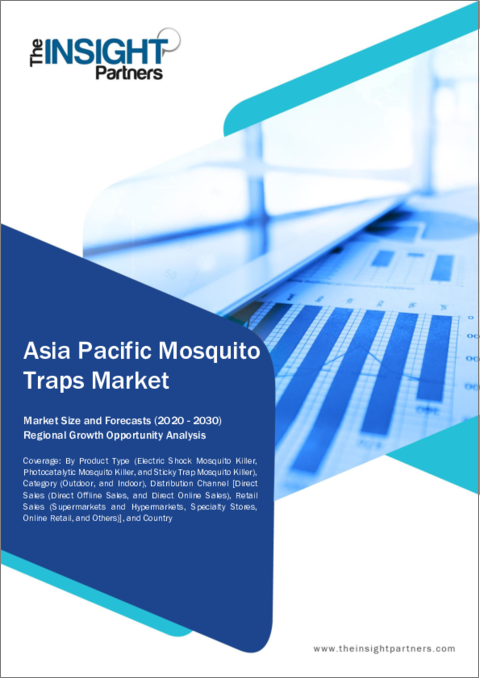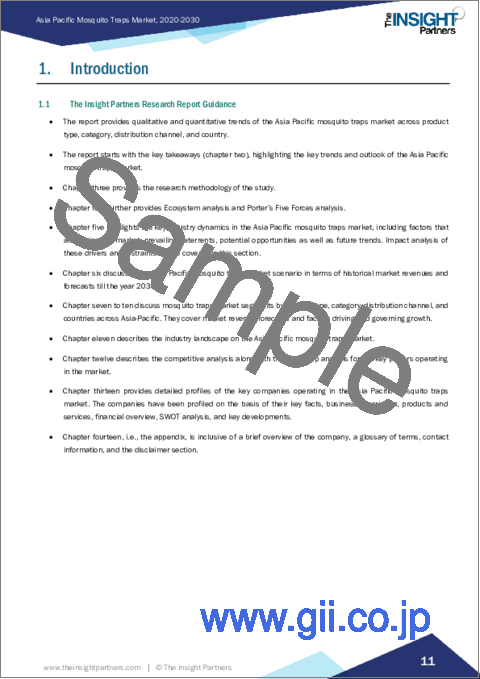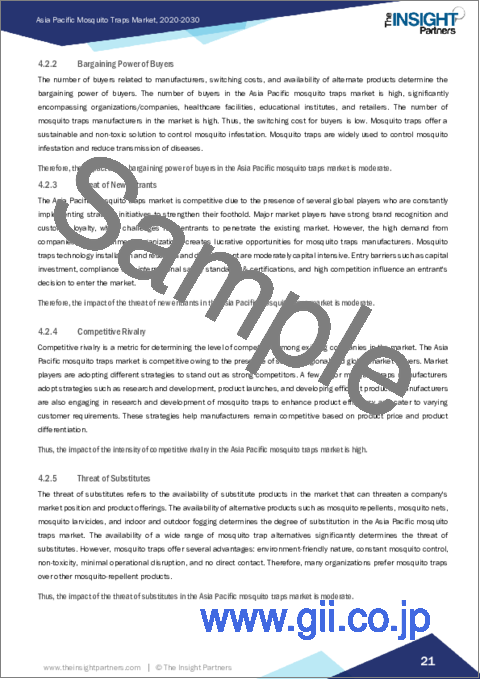|
|
市場調査レポート
商品コード
1402749
アジア太平洋地域の蚊取り器市場の2030年までの予測-地域別分析:製品タイプ別、カテゴリー別、流通チャネル別Asia Pacific Mosquito Traps Market Forecast to 2030 - Regional Analysis - by Product Type (Electric Shock Mosquito Killer, Photocatalytic Mosquito Killer, and Sticky Trap Mosquito Killer), Category (Outdoor and Indoor), and Distribution Channel |
||||||
|
|||||||
| アジア太平洋地域の蚊取り器市場の2030年までの予測-地域別分析:製品タイプ別、カテゴリー別、流通チャネル別 |
|
出版日: 2023年11月20日
発行: The Insight Partners
ページ情報: 英文 71 Pages
納期: 即納可能
|
- 全表示
- 概要
- 図表
- 目次
アジア太平洋地域の蚊取り器市場は、2022年の1億3,618万米ドルから2030年には2億3,842万米ドルに成長すると予測されています。2022年から2030年までのCAGRは7.3%で成長すると推定されます。
蚊取り器市場における戦略的製品発表とイノベーションがアジア太平洋地域の蚊取り器市場を牽引
世界中のメーカーや研究者は、効果的で環境に優しく、ユーザーフレンドリーで効率的な蚊の駆除ソリューションの開発に努めています。蚊取り器市場における技術革新は、性能の向上、蚊の捕獲率の向上、ユーザーエクスペリエンスの向上を目指しています。2021年、Rentokil PCIはLEDライトを利用した環境に優しい蚊取り器、Mosclean IG1を発売しました。2022年、マレーシアのTATIユニバーシティ・カレッジの研究者は、大気質モニター付きのソーラー式蚊取り器を開発しました。このソーラー式蚊取り器は、ファンで蚊を吸い込み、内蔵されたLEDでおびき寄せることで蚊を捕獲する仕組みになっています。この製品には、周囲の温度や二酸化炭素の変化を検知する空気環境モニターが搭載されました。このように、絶え間ない戦略的製品の発売とイノベーションが、アジア太平洋地域の蚊取り器市場を押し上げると期待されています。
アジア太平洋地域の蚊取り器市場の概要
アジア太平洋地域の蚊取り器市場は、オーストラリア、中国、インド、日本、韓国、その他アジア太平洋地域に区分されます。アジア太平洋地域の蚊取り器市場は、蚊が媒介する疾病の増加や、健康に対する人々の関心の高まりなどの要因によって牽引されています。WHOが実施したデング熱の流行に関する調査では、39億人がデングウイルスに感染するリスクがあり、その70%がアジアに居住していると推定されています。保健・家族福祉省の国務大臣が発表したデータによると、インドでは2022年に233,251人近くのデング熱患者が報告されました。NCVBDC(National Center for Vector Borne Diseases Control)がまとめたデータによると、2022年にインドで死亡したデング熱患者は303人でした。蚊が媒介する疾病の制御と予防の重要な側面は、ウイルスを媒介する蚊を減らすことです。蚊取り器は、蚊を媒介するウイルスの密度を減らし、蚊が媒介する病気の蔓延を抑えるのに役立ちます。従って、この地域における蚊媒介性疾患の増加は、蚊取り器の需要を促進します。アジア太平洋地域の蚊取り器市場で事業を展開するINZECTOやWoodstream Corporationなどの主要企業は、研究開発活動への投資や新製品の発売など、さまざまな戦略を採用しています。
アジア太平洋地域の蚊取り器市場の収益と2030年までの予測(金額)
アジア太平洋地域の蚊取り器市場のセグメンテーション
アジア太平洋地域の蚊取り器市場は、製品タイプ、カテゴリー、流通チャネル、国別に区分されます。
製品タイプ別では、アジア太平洋地域の蚊取り器市場は、電気ショック蚊取り器、光触媒蚊取り器、粘着トラップ蚊取り器に区分されます。2022年には、電気ショック蚊取り器セグメントがアジア太平洋地域の蚊取り器市場で最大のシェアを記録しました。
カテゴリーに基づくと、アジア太平洋地域の蚊取り器市場は屋外と屋内に二分されます。2022年、アジア太平洋地域の蚊取り器市場では、屋内セグメントがより大きなシェアを記録しました。
流通チャネルでは、アジア太平洋地域の蚊取り器市場は直接販売と小売販売に二分されます。2022年には、小売販売セグメントがアジア太平洋地域の蚊取り器市場でより大きなシェアを記録しました。直販セグメントはさらにオフライン直販とオンライン直販に区分されます。小売販売セグメントはさらにスーパーマーケット・ハイパーマーケット、専門店、オンライン小売、その他に区分されます。
国別では、アジア太平洋蚊取り市場は、オーストラリア、中国、インド、日本、韓国、その他アジア太平洋地域に区分されます。2022年には、その他アジア太平洋地域がアジア太平洋地域の蚊取り器市場で最大のシェアを記録しました。
目次
第1章 イントロダクション
第2章 エグゼクティブサマリー
- 主要洞察
- 市場の魅力
第3章 調査手法
- 調査範囲
- 2次調査
- 1次調査
- 限界と前提条件
第4章 アジア太平洋地域の蚊取り器市場情勢
- ポーターのファイブフォース分析
- 供給企業の交渉力
- 買い手の交渉力
- 新規参入業者の脅威
- 競争企業間の敵対関係
- 代替品の脅威
- エコシステム分析
- 原材料サプライヤー
- メーカー
- ディストリビューター/サプライヤー
- エンドユーザー
- バリューチェーンのベンダー一覧
第5章 アジア太平洋地域の蚊取り器市場:主要市場力学
- 市場促進要因
- 高まる政府の取り組みと啓発キャンペーン
- 環境に優しい蚊の駆除方法に対する好みの高まり
- 市場抑制要因
- 代替蚊駆除方法の利用可能性
- 市場機会
- eコマースとオンライン販売チャネルがもたらす利便性
- 今後の動向
- 蚊取り器市場における戦略的製品発表とイノベーション
- 影響分析
第6章 蚊取り器市場:アジア太平洋地域の市場分析
- アジア太平洋地域の蚊取り器市場の収益
- アジア太平洋地域の蚊取り器市場の予測と分析
第7章 アジア太平洋地域の蚊取り器市場分析:製品タイプ別
- 電気ショック蚊取り器
- 光触媒蚊取り器
- 粘着トラップ蚊取り器
第8章 アジア太平洋地域の蚊取り器市場分析:カテゴリー別
- 屋外
- 屋内
第9章 アジア太平洋地域の蚊取り器市場分析:流通チャネル別
- 直接販売
- オフライン直接販売
- オンライン直接販売
- 小売販売
- スーパーマーケット・ハイパーマーケット
- 専門店
- オンライン小売
- その他
第10章 アジア太平洋地域の蚊取り器市場:国別分析
第11章 業界情勢
- 新製品開発
- 合併と買収
第12章 競合情勢
- 主要プレーヤー別ヒートマップ分析
- 企業のポジショニングと集中度
第13章 企業プロファイル
- Woodstream Corp
- Inzecto Corp
- Shenzhen Tesenni Industrial Co Ltd
- Biogents AG
第14章 付録
List Of Tables
- Table 1. Asia Pacific Mosquito Traps Market Segmentation
- Table 2. Asia Pacific Mosquito Traps Market Revenue and Forecasts To 2030 (US$ Million)
- Table 3. Asia Pacific Mosquito Traps Market Revenue and Forecasts To 2030 (US$ Million) - Product Type
- Table 4. Asia Pacific Mosquito Traps Market Revenue and Forecasts To 2030 (US$ Million) - Category
- Table 5. Asia Pacific Mosquito Traps Market Revenue and Forecasts To 2030 (US$ Million) - Distribution Channel
- Table 6. Australia Mosquito Traps Market Revenue and Forecasts To 2030 (US$ Million) - Product Type
- Table 7. Australia Mosquito Traps Market Revenue and Forecasts To 2030 (US$ Million) - Category
- Table 8. Australia Mosquito Traps Market Revenue and Forecasts To 2030 (US$ Million) - Distribution Channel
- Table 9. China Mosquito Traps Market Revenue and Forecasts To 2030 (US$ Million) - Product Type
- Table 10. China Mosquito Traps Market Revenue and Forecasts To 2030 (US$ Million) - Category
- Table 11. China Mosquito Traps Market Revenue and Forecasts To 2030 (US$ Million) - Distribution Channel
- Table 12. India Mosquito Traps Market Revenue and Forecasts To 2030 (US$ Million) - Product Type
- Table 13. India Mosquito Traps Market Revenue and Forecasts To 2030 (US$ Million) - Category
- Table 14. India Mosquito Traps Market Revenue and Forecasts To 2030 (US$ Million) - Distribution Channel
- Table 15. Japan Mosquito Traps Market Revenue and Forecasts To 2030 (US$ Million) - Product Type
- Table 16. Japan Mosquito Traps Market Revenue and Forecasts To 2030 (US$ Million) - Category
- Table 17. Japan Mosquito Traps Market Revenue and Forecasts To 2030 (US$ Million) - Distribution Channel
- Table 18. South Korea Mosquito Traps Market Revenue and Forecasts To 2030 (US$ Million) - Product Type
- Table 19. South Korea Mosquito Traps Market Revenue and Forecasts To 2030 (US$ Million) - Category
- Table 20. South Korea Mosquito Traps Market Revenue and Forecasts To 2030 (US$ Million) - Distribution Channel
- Table 21. Rest of Asia Pacific Mosquito Traps Market Revenue and Forecasts To 2030 (US$ Million) - Product Type
- Table 22. Rest of Asia Pacific Mosquito Traps Market Revenue and Forecasts To 2030 (US$ Million) - Category
- Table 23. Rest of Asia Pacific Mosquito Traps Market Revenue and Forecasts To 2030 (US$ Million) - Distribution Channel
- Table 24. Company Positioning & Concentration
List Of Figures
- Figure 1. Asia Pacific Mosquito Traps Market Segmentation, By Country
- Figure 2. Porter's Five Forces Analysis
- Figure 3. Ecosystem Analysis: Asia Pacific Mosquito Traps Market
- Figure 4. Asia Pacific Mosquito Traps Market - Key Industry Dynamics
- Figure 5. Asia Pacific Mosquito Traps Market Impact Analysis of Drivers and Restraints
- Figure 6. Asia Pacific Mosquito Traps Market Revenue (US$ Million), 2020 - 2030
- Figure 7. Asia Pacific Mosquito Traps Market Share (%) - Product Type, 2022 and 2030
- Figure 8. Electric Shock Mosquito Killer Market Revenue and Forecasts To 2030 (US$ Million)
- Figure 9. Photocatalytic Mosquito Killer Market Revenue and Forecasts To 2030 (US$ Million)
- Figure 10. Sticky Trap Mosquito Killer Market Revenue and Forecasts To 2030 (US$ Million)
- Figure 11. Asia Pacific Mosquito Traps Market Share (%) -Category, 2022 and 2030
- Figure 12. Outdoor Market Revenue and Forecasts To 2030 (US$ Million)
- Figure 13. Indoor Market Revenue and Forecasts To 2030 (US$ Million)
- Figure 14. Asia Pacific Mosquito Traps Market Share (%) - Distribution Channel, 2022 and 2030
- Figure 15. Direct Sales Market Revenue and Forecasts To 2030 (US$ Million)
- Figure 16. Direct Offline Sales Market Revenue and Forecasts To 2030 (US$ Million)
- Figure 17. Direct Online Sales Market Revenue and Forecasts To 2030 (US$ Million)
- Figure 18. Retail Sales Market Revenue and Forecasts To 2030 (US$ Million)
- Figure 19. Supermarkets and Hypermarkets Market Revenue and Forecasts To 2030 (US$ Million)
- Figure 20. Specialty Stores Market Revenue and Forecasts To 2030 (US$ Million)
- Figure 21. Online Retail Market Revenue and Forecasts To 2030 (US$ Million)
- Figure 22. Others Market Revenue and Forecasts To 2030 (US$ Million)
- Figure 23. Asia Pacific Mosquito Traps Market By Key Countries- Revenue (2022) ( US$ Million)
- Figure 24. Asia Pacific Mosquito Traps Market Breakdown By Key Countries, 2022 And 2030 (%)
- Figure 25. Australia Mosquito Traps Market Revenue and Forecasts To 2030 (US$ Million)
- Figure 26. China Mosquito Traps Market Revenue and Forecasts To 2030 (US$ Million)
- Figure 27. India Mosquito Traps Market Revenue and Forecasts To 2030 (US$ Million)
- Figure 28. Japan Mosquito Traps Market Revenue and Forecasts To 2030 (US$ Million)
- Figure 29. South Korea Mosquito Traps Market Revenue and Forecasts To 2030 (US$ Million)
- Figure 30. Rest of Asia Pacific Mosquito Traps Market Revenue and Forecasts To 2030 (US$ Million)
- Figure 31. Heat Map Analysis By Key Players
The Asia Pacific mosquito traps market is expected to grow from US$ 136.18 million in 2022 to US$ 238.42 million by 2030. It is estimated to grow at a CAGR of 7.3% from 2022 to 2030.
Strategic Product Launches and Innovations in Mosquito Traps Market Drives Asia Pacific Mosquito Traps Market
Manufacturers and researchers across the globe strive to develop effective, eco-friendly, user-friendly, and efficient mosquito control solutions. The innovations in the mosquito trap market aim to improve performance, increase mosquito capture rate, and enhance user experience. In 2021, Rentokil PCI launched Mosclean IG1, an eco-friendly mosquito trap based on LED light. Mosclean IG1 is water resistant mosquito control solution for outdoor applications with a coverage area of up to one acre. The product is a nontoxic mosquito control solution and works on a photocatalytic reaction that releases carbon dioxide, thereby killing mosquitoes particularly responsible for Zika virus transmission. In 2022, researchers from TATI University College, Malaysia, developed a solar-powered mosquito trap with an air-quality monitor. The solar-powered mosquito trap mechanism is designed to capture mosquitoes by sucking them in with a fan and luring them in with an integrated LED. The product was equipped with an air quality monitor to detect variations in temperature and carbon dioxide in the surroundings. Thus, constant strategic product launches and innovations are expected to boost the Asia Pacific mosquito traps market .
Asia Pacific Mosquito Traps Market Overview
The Asia Pacific mosquito traps market is segmented into Australia, China, India, Japan, South Korea, and the Rest of Asia Pacific. The Asia Pacific mosquito traps market is driven by factors such as the rising number of mosquito-borne diseases and growing concern among people regarding their health. A study on the prevalence of dengue conducted by the WHO estimates that 3.9 billion people are at risk of infection with dengue viruses, with 70% residing in Asia. According to the data released by ReliefWeb, a humanitarian information portal, in July 2023, children are at high risk due to increased dengue fever across Asia Pacific. The situation is expected to worsen in the coming weeks as floods, heatwaves, and potential impacts of the El Nino weather event create perfect breeding grounds for mosquitoes. Countries such as Malaysia and Cambodia are also witnessing a surge in dengue cases and reporting much higher case numbers than in 2022. According to the data presented by the Minister of State for the Ministry of Health and family welfare, nearly 233,251 dengue cases were reported in India in 2022. According to data compiled by the National Center for Vector Borne Diseases Control (NCVBDC), 303 dengue patients died in India in 2022. An important aspect of controlling and preventing mosquito-borne diseases is to reduce mosquitoes that carry viruses. Mosquito traps help reduce the density of mosquito vectors and the spread of mosquito-borne diseases. Thus, the rising number of mosquito-borne diseases in the region drives the demand for mosquito traps. Key Players such as INZECTO and Woodstream Corporation operating in the Asia Pacific mosquito traps market are adopting various strategies, such as investment in research and development activities and new product launches. In August 2021, Rentokil PCI, a pest control service provider in India, unveiled an innovative product-based solution-Mosclean IG1-to address the rising threat of mosquito-borne illnesses. This solution is environment-friendly, with the potential to cover a wide area. In addition, Mosclean IG1 is an eco-friendly mosquito trap that attracts mosquitoes using LED lights. The trap is scientifically proven to catch and kill mosquitoes, particularly those transmitting the Zika virus.
Asia Pacific Mosquito Traps Market Revenue and Forecast to 2030 (US$ Million)
Asia Pacific Mosquito Traps Market Segmentation
The Asia Pacific mosquito traps market is segmented into product type, category, distribution channel, and country.
Based on product type, the Asia Pacific mosquito traps market is segmented into electric shock mosquito killer, photocatalytic mosquito killer, and sticky trap mosquito killer. In 2022, the electric shock mosquito killer segment registered the largest share in the Asia Pacific mosquito traps market.
Based on category, the Asia Pacific mosquito traps market is bifurcated into outdoor and indoor. In 2022, the indoor segment registered a larger share in the Asia Pacific mosquito traps market.
Based on distribution channel, the Asia Pacific mosquito traps market is bifurcated into direct sales and retail sales. In 2022, the retail sales segment registered a larger share in the Asia Pacific mosquito traps market. The direct sales segment is further segmented into direct offline sales and direct online sales. The retail sales segment is further segmented into supermarkets & hypermarkets, specialty stores, online retail, and others.
Based on country, the Asia Pacific mosquito traps market is segmented into Australia, China, India, Japan, South Korea, and the Rest of Asia Pacific. In 2022, the Rest of Asia Pacific registered the largest share in the Asia Pacific mosquito traps market.
Biogents AG, Inzecto Corp, Shenzhen Tesenni Industrial Co Ltd, Woodstream Corp are some of the leading companies operating in the Asia Pacific mosquito traps market.
Reasons to Buy:
- Save and reduce time carrying out entry-level research by identifying the growth, size, leading players, and segments in the Asia Pacific mosquito traps market
- Highlights key business priorities in order to assist companies to realign their business strategies
- The key findings and recommendations highlight crucial progressive industry trends in the Asia Pacific mosquito traps market, thereby allowing players across the value chain to develop effective long-term strategies
- Develop/modify business expansion plans by using substantial growth offering developed and emerging markets
- Scrutinize in-depth Asia Pacific market trends and outlook coupled with the factors driving the mosquito traps market, as well as those hindering it
- Enhance the decision-making process by understanding the strategies that underpin commercial interest with respect to client products, segmentation, pricing, and distribution
Table Of Contents
1. Introduction
- 1.1 The Insight Partners Research Report Guidance
- 1.2 Market Segmentation
2. Executive Summary
- 2.1 Key Insights
- 2.2 Market Attractiveness
3. Research Methodology
- 3.1 Coverage
- 3.2 Secondary Research
- 3.3 Primary Research
- 3.4 Limitations and Assumptions
4. Asia Pacific Mosquito Traps Market Landscape
- 4.1 Overview
- 4.2 Porter's Five Forces Analysis
- 4.2.1 Bargaining Power of Suppliers
- 4.2.2 Bargaining Power of Buyers
- 4.2.3 Threat of New Entrants
- 4.2.4 Competitive Rivalry
- 4.2.5 Threat of Substitutes
- 4.3 Ecosystem Analysis
- 4.3.1 Raw Material Suppliers
- 4.3.2 Manufacturers
- 4.3.3 Distributors/Suppliers
- 4.3.4 End-Users
- 4.3.5 List of Vendors in the Value Chain
5. Asia Pacific Mosquito Traps Market - Key Market Dynamics
- 5.1 Market Drivers
- 5.1.1 Growing Government Initiatives and Awareness Campaigns
- 5.1.2 Rising Preference for Environment-Friendly Mosquito Control Method
- 5.2 Market Restraints
- 5.2.1 Availability of Alternative Mosquito Control Methods
- 5.3 Market Opportunity
- 5.3.1 Convenience Driven by E-Commerce and Online Sales Channel
- 5.4 Future Trends
- 5.4.1 Strategic Product Launches and Innovations in Mosquito Traps Market
- 5.5 Impact Analysis
6. Mosquito Traps Market - Asia Pacific Market Analysis
- 6.1 Asia Pacific Mosquito Traps Market Revenue (US$ Million)
- 6.2 Asia Pacific Mosquito Traps Market Forecast and Analysis
7. Asia Pacific Mosquito Traps Market Analysis - Product Type
- 7.1 Electric Shock Mosquito Killer
- 7.1.1 Overview
- 7.1.2 Electric Shock Mosquito Killer Market Revenue and Forecast to 2030 (US$ Million)
- 7.2 Photocatalytic Mosquito Killer
- 7.2.1 Overview
- 7.2.2 Photocatalytic Mosquito Killer Market Revenue and Forecast to 2030 (US$ Million)
- 7.3 Sticky Trap Mosquito Killer
- 7.3.1 Overview
- 7.3.2 Sticky Trap Mosquito Killer Market Revenue and Forecast to 2030 (US$ Million)
8. Asia Pacific Mosquito Traps Market Analysis - Category
- 8.1 Outdoor
- 8.1.1 Overview
- 8.2 Indoor
- 8.2.1 Overview
9. Asia Pacific Mosquito Traps Market Analysis - Distribution Channel
- 9.1 Direct Sales
- 9.2 Direct Offline Sales
- 9.2.1 Overview
- 9.2.2 Direct Offline Sales Market Revenue, and Forecast to 2030 (US$ Million)
- 9.3 Direct Online Sales
- 9.3.1 Overview
- 9.3.2 Direct Online Sales Market Revenue, and Forecast to 2030 (US$ Million)
- 9.4 Retail Sales
- 9.4.1 Retail Sales Market Revenue and Forecast to 2030 (US$ Million)
- 9.5 Supermarkets and Hypermarkets
- 9.5.1 Overview
- 9.5.2 Supermarkets and Hypermarkets Market Revenue and Forecast to 2030 (US$ Million)
- 9.6 Specialty Stores
- 9.6.1 Overview
- 9.6.2 Specialty Stores Market Revenue and Forecast to 2030 (US$ Million)
- 9.7 Online Retail
- 9.7.1 Overview
- 9.7.2 Online Retail Market Revenue and Forecast to 2030 (US$ Million)
- 9.8 Others
- 9.8.1 Overview
- 9.8.2 Others Market Revenue and Forecast to 2030 (US$ Million)
- 9.8.3 Others segment accounted for US$ 15.87 million in 2022 and is expected to reach US$ 24.34 million by 2030. The growth rate of this segment is projected to be 5.5% during the forecast period.
10. Asia Pacific Mosquito Traps Market - Country Analysis
- 10.1 Overview
- 10.1.1 Asia Pacific Mosquito Traps Market Breakdown by Country
- 10.1.1.1 Mosquito Traps Market Breakdown by Country
- 10.1.1.2 Australia Mosquito Traps Market Revenue and Forecasts To 2030 (US$ Million)
- 10.1.1.2.1 Australia Mosquito Traps Market Breakdown by Product Type
- 10.1.1.2.2 Australia Mosquito Traps Market Breakdown by Category
- 10.1.1.2.3 Australia Mosquito Traps Market Breakdown by Distribution Channel
- 10.1.1.3 China Mosquito Traps Market Revenue and Forecasts To 2030 (US$ Million)
- 10.1.1.3.1 China Mosquito Traps Market Breakdown by Product Type
- 10.1.1.3.2 China Mosquito Traps Market Breakdown by Category
- 10.1.1.3.3 China Mosquito Traps Market Breakdown by Distribution Channel
- 10.1.1.4 India Mosquito Traps Market Revenue and Forecasts To 2030 (US$ Million)
- 10.1.1.4.1 India Mosquito Traps Market Breakdown by Product Type
- 10.1.1.4.2 India Mosquito Traps Market Breakdown by Category
- 10.1.1.4.3 India Mosquito Traps Market Breakdown by Distribution Channel
- 10.1.1.5 Japan Mosquito Traps Market Revenue and Forecasts To 2030 (US$ Million)
- 10.1.1.5.1 Japan Mosquito Traps Market Breakdown by Product Type
- 10.1.1.5.2 Japan Mosquito Traps Market Breakdown by Category
- 10.1.1.5.3 Japan Mosquito Traps Market Breakdown by Distribution Channel
- 10.1.1.6 South Korea Mosquito Traps Market Revenue and Forecasts To 2030 (US$ Million)
- 10.1.1.6.1 South Korea Mosquito Traps Market Breakdown by Product Type
- 10.1.1.6.2 South Korea Mosquito Traps Market Breakdown by Category
- 10.1.1.6.3 South Korea Mosquito Traps Market Breakdown by Distribution Channel
- 10.1.1.7 Rest of Asia Pacific Mosquito Traps Market Revenue and Forecasts To 2030 (US$ Million)
- 10.1.1.7.1 Rest of Asia Pacific Mosquito Traps Market Breakdown by Product Type
- 10.1.1.7.2 Rest of Asia Pacific Mosquito Traps Market Breakdown by Category
- 10.1.1.7.3 Rest of Asia Pacific Mosquito Traps Market Breakdown by Distribution Channel
- 10.1.1 Asia Pacific Mosquito Traps Market Breakdown by Country
11. Industry Landscape
- 11.1 Overview
- 11.2 New Product Development
- 11.3 Merger and Acquisition
12. Competitive Landscape
- 12.1 Heat Map Analysis By Key Players
- 12.2 Company Positioning & Concentration
13. Company Profiles
- 13.1 Woodstream Corp
- 13.1.1 Key Facts
- 13.1.2 Business Description
- 13.1.3 Products and Services
- 13.1.4 Financial Overview
- 13.1.5 SWOT Analysis
- 13.1.6 Key Developments
- 13.2 Inzecto Corp
- 13.2.1 Key Facts
- 13.2.2 Business Description
- 13.2.3 Products and Services
- 13.2.4 Financial Overview
- 13.2.5 SWOT Analysis
- 13.2.6 Key Developments
- 13.3 Shenzhen Tesenni Industrial Co Ltd
- 13.3.1 Key Facts
- 13.3.2 Business Description
- 13.3.3 Products and Services
- 13.3.4 Financial Overview
- 13.3.5 SWOT Analysis
- 13.3.6 Key Developments
- 13.4 Biogents AG
- 13.4.1 Key Facts
- 13.4.2 Business Description
- 13.4.3 Products and Services
- 13.4.4 Financial Overview
- 13.4.5 SWOT Analysis
- 13.4.6 Key Developments






